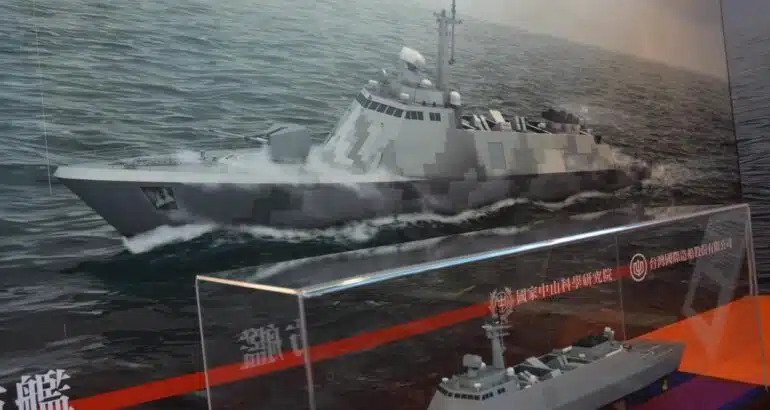INDUSTRY NEWS

Taiwan To Begin Light Frigate Construction In June
May 22, 2023
By:Curtis Lee
A relatively early internal Light Frigate concept design by the National Chung-Shan Institute of Science & Technology, unveiled in the 2018 Kaohsiung International Maritime & Defence Expo.
Taiwan is set to start construction of two 2,500-ton Light Frigates in June following a contract awarded to a local shipbuilder this month.
The new frigates would supplement the larger existing frigates and destroyers, relieving their operational stress.
According to multiple Taiwanese media outlets, the Republic of China (ROC) Navy signed a contract with Jong Shyn Shipbuilding Group to build their first two next generation domestic Light Frigates on May 12th and is expected to begin construction as soon as June, paving the road to introduce 12 frigates for the Taiwanese Navy.
Currently, the ROC Navy operates 22 Frigates, including 10 Cheng Keung-class Frigates (8 license-produced US Perry class plus 2 second-hand ships from the US Navy), 6 Kang Ding-class Frigates (Modified French La Fayette-class built by the then-DCNS, now Naval Group) and 6 Chun Yang-class Frigates (Second-hand US Knox-class). Back in 2016, the Taiwanese Navy had a plan to replace these 3 classes of Frigates with a single new class of 4,500-ton Guided Missile Frigates. The new class aimed at becoming the backbone of the ROC Navy, featuring 3D Phased Array Radar and Vertical Launch System; however, this plan was suspended in 2021 and the resources were prioritized to a new 2,500-ton Light Frigate program.
The current 22 Frigates of Taiwan are classified as “First class ships”, with displacements ranging from around 3,600-ton to 4,200-ton and their role is to fight the high-end battles. The new 2,500-ton Light Frigates are classified as “Second class ships”, acting as the workhorses of the Taiwanese Navy, taking over the day-to-day patrol missions currently performed by the “First class ships” and filling the existing gap between the “First class ships” and “Third class ships”, which are the smaller Corvettes and Missile Boats. In order to reduce the cost, the ROC Navy decided to take a role-oriented approach by splitting the Light Frigate into two versions, the AAW version and ASW version. That is because integrating all these mission systems and equipment together would definitely increase the displacement of the ship which would ultimately increase the overall cost of the program.
Light Frigate, the workhorse of the Navy
Both versions are around 101 meters in length, 12.3 meters to 12.6 meters in width and 3.75 meters to 3.9 meters in draft. According to local reports, the Taiwanese Navy selected Lockheed Martin Canada‘s CMS-330 as the Combat Management System for the Light Frigate, the same system found on the current Arctic and Offshore Patrol Ship as well as the future Canadian Surface Combatant and Joint Support Ship of the Royal Canadian Navy. In addition, they are also in the process of introducing OTO Melera’s 76mm STRALES and DART (Driven Ammunition Reduced Time of flight) in the future, which should be part of the Light Frigate program.
Just like every other surface combatants in the Taiwanese Navy, the Phalanx Close-In Weapon System would be the last line of defense against Anti-Ship Missiles; however, the Sea Oryx Missile System (A Taiwanese domestic equivalent to the US Rolling Airframe Missile System) would also be integrated in the future once the whole Operational Test & Evaluation (OT&E) phase is completed and ready for series production.
As for the medium range air surveillance radar for the Light Frigate, BAE Systems‘ ARTISAN (Advanced Radar Target Indication Situational Awareness and Navigation) was selected as the primary radar system. Designated as Type 997 in the British Royal Navy, the ARTISAN is a proved and reliable 3D S Band Radar system with Digital Beam Forming capability rotating at 30 RPM, allowing the Light Frigate to maintain an excellent air surveillance capability and situational awareness.
TC-2N, a ship-launched version of the domestic Sky Sword II Medium Range, Active Radar Homing Air to Air Missile is the primary AAW weapon for both versions of the Light Frigate. One notable feature of the AAW version is the integration of a domestic VLS with 32 cells for the TC-2N, which is the first class of Taiwanese ship to integrate such system. On the other hand, the ASW version would install two side launchers with 8 cells, which only has about half the missiles compared to the AAW version.
In order to perform Local Sea Control mission, both versions are armed with HF-2 Subsonic Anti-Ship Missiles and HF-3 Supersonic Anti-Ship Missiles. The AAW version can only carry 8 Anti-Ship Missiles while the ASW version can carry up to 16 missiles, depending on the type of missiles. All domestic missiles would be controlled by a domestic combat system, linked to the onboard CMS-330. Due to the relatively light tonnage of the Light Frigate, the thought of installing a hull-mounted sonar on the ship was abandoned from the start of the program. Only the ASW version is equipped with a towed Variable Depth Sonar, presumably the CAPTAS series VDS. 2 sets of Mk32 Surface Vessel Torpedo Tubes are also an exclusive feature for the ASW version.
The first batch of 2 Light Frigates, consisting of one AAW and ASW version each, would start the construction as soon as the power plant selection (Rolls Royce MT30 and General Electric LM2500 Gas Turbines are the possible candidates) and other detailed designs are completed. Despite the rushed schedule, the Taiwanese Navy is quite optimistic that both ships should be able to begin construction in June and on track to be delivered in October, 2026.
Source:
https://www.navalnews.com/naval-news/2023/05/taiwan-to-begin-light-frigate-construction-in-june/

